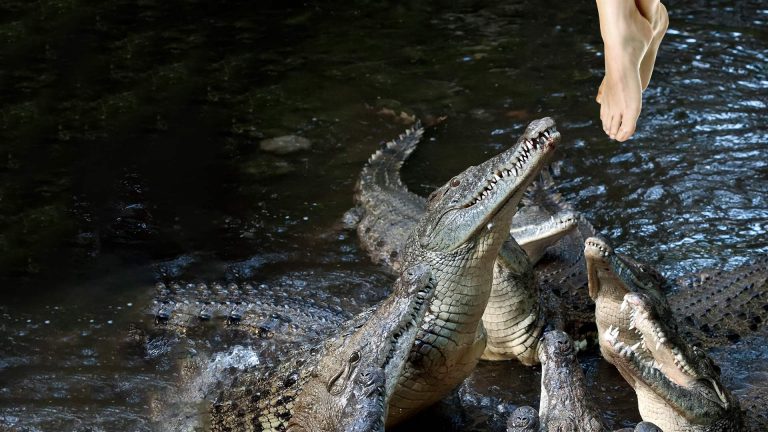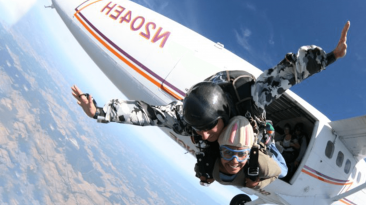A crocodile may swim by unassumingly but make no mistake, they are on the hunt for their next prey. Crocodiles have heightened smell, sight and hearing, and can hold their breath for over an hour. Their ability to lurk underwater makes them the third most dangerous predator in all of Africa.
The freshwater Nile crocodile is one of the deadliest animals on the Nile River, with a wildlife carcass count only behind that of lions and hippos. The good news is, only 7 of the 23 known croc species are considered dangerous to humans.
The bad news is, the one in front of you is one of those seven, and it’s very, very hungry. Crocodiles can be extremely aggressive and can weigh more than 900 kg (2,000 lb) with an average length of 5.8 meters (19 feet). When one tries to get you, it’s estimated to be 100 times deadlier than a shark attack.
Just because you don’t live in Africa doesn’t mean you shouldn’t worry about encountering a croc. Crocodiles can also be found on three other continents, including the Americas, Asia and Australia.
And don’t let their short legs fool you. These beasts can swim up to 32 km/h (20 mph) and can run up to almost 18 km/h (11 mph). Hopefully, you are on land and can run fast in a straight line. Or at least faster than the person next to you.
Is running fast your best action? Should you punch it in the nose like a shark? Will it be satisfied with just one bite?
Step 1: Go for the Eyes
A crocodile’s eyes are extra vulnerable, as Australian survivor Stephen Moreen discovered. After being pulled into water by this ferocious brute, Moreen managed to jab the crocodile in the eyes, giving him time to swim away from certain death.
Gouge or poke the eyes with all of your strength. Go for its ears, nostrils, and if one of your limbs is already in its mouth, go for the palatal valve. That’s the flap of skin that covers the back of a croc’s throat. By striking at this valve repeatedly, water will get in and start to drown your foe. And remember, time is of the essence.
Step 2: Stay Away From Its Jaws
A crocodile’s jaw can generate up to 34,500 kilopascal (5,000 pound-force per square inch) of pressure and is fifty times stronger than a human’s bite. They can savagely tear into anything from flesh to bone in mere seconds.
Don’t waste your precious energy trying to open the croc’s jaw. Once it’s locked, no amount of struggle will release it. Keep your energy for the real fight.
Step 3: Watch Out for the Death Roll
Once clenched in the jaws, it will toss you around harshly to position you. This enables the croc to tip its head back and quickly slide you down its ample throat. If this move fails, get prepared for the upcoming death roll. Hold your breath as it pulls you beneath the water and roll in the same direction as the croc, without fighting against it. If you want to avoid limb loss and extensive injuries, that is.
It isn’t called the death roll for nothing. This maneuver allows the crocodile to drown its prey and forcibly rip off any pesky limbs. It likes a streamline snack to swallow whole cause its powerful jaws don’t chew well. Death rolls take a lot of energy so the croc will need to rest before trying again. Use this brief pause to immediately fight with more gusto. It may be your last chance to do so.
Step 4: Grab Onto Something
If you’re on land before an attack occurs, it’s imperative you do not let a crocodile drag you into nearby water. Grab a tree, a rock, or anything else you can to hold your ground.
You don’t want this deadly creature to pull you to the dark depths of its natural habitat. With an incredible ability to hold its breath underwater, this is where the crocodile is most comfortable to kill its prey. Here in the murkiness, it will take whatever time is necessary to overpower and drown you.
Step 5: Cry Out for Help
Scream, make noise, do whatever you have to do to let people know where you are and what is happening. Others arriving on the scene might encourage the croc to retreat from its treat. Keep in mind, this animal’s apex predatory instincts are strong, evolving from the prehistoric period and becoming its own species 55 million years ago.
Since the crocodile is a risk-averse, opportunistic carnivore, it wants an easy ambush to kill and satisfy its voracious appetite. Waiting patiently for days at the water’s edge to suddenly and unpredictably attack defenceless prey is what it knows best. Don’t give it the chance to succeed.
With any luck, you won’t be attacked by other prehistoric creatures. But to be prepared and stay alive, keep watching How to Survive.
Sources
- “Crocodilian Species Range”. National Geographic Society.
- “What to do if you get Caught by a Gator or Croc”. 2020. Be Prepared – Emergency Essentials.
- “How To ACTUALLY Survive a Crocodile Attack”. youtube.com.
- “Crocodile Uses Its Tail To Propel Itself Out Of The Water [VIDEO]”. 2015. detroit.cbslocal.com.
- “Woman scares off crocodile with flip-flop in Australia”. 2020. BBC News.
- “Tipsy Australian fights off crocodile with eye-poke”. 2014. BBC News.
- “7 Crocodilian Species That Are Dangerous To Humans”. 2020. Encyclopedia Britannica.


















